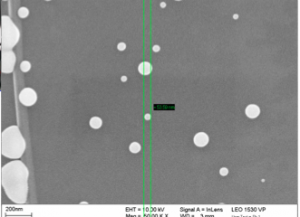Imagine a miniature drone that fits on your fingertip, complete with a built-in camera and microphone. The possibilities are endless: it could serve the military for espionage or help Yalies scope out potential screw dates. To power such a drone, researchers would need to develop a micro-motor made of low-friction material capable of running for extended periods of time. A recent collaboration between Professor of Mechanical Engineering & Materials Science Udo Schwarz and scientists at two German universities may help boost development of such low-friction materials. They showed that at an atomic scale, the principles of friction deviate from those at a macroscopic scale.
On a macroscopic level, friction does not depend on surface area. An organic chemistry textbook will slide the same distance whether you push it flat or upright along on the table. The surface of the table has tiny peaks that come in contact with those of the book surface. In order for the book to keep sliding, the book’s surface has to overcome these peaks on the table, which translates into lost energy, or friction. The rougher the surface, the more friction is created.

At a microscopic scale, the same concept holds — atoms from one surface obstruct atoms from the other surface, creating a potential energy barrier, or peak, that must be overcome. The lower an atom is nestled into a “valley,” the harder it is for it to come back up to allow the surface to continue sliding. If, however, two surfaces have different spacing between atoms, then the “hills and valleys” of the two surfaces will not line up. Atoms from one surface will not be caught in the valleys of the other surface, reducing friction in a phenomenon called structural lubricity.
One of the key theories of structural lubricity is that there is an unusual frictional dependence on surface area. Schwarz and his collaborators showed that the friction force does, in fact, depend on contact area at the atomic scale — an observation unique to the microscopic level. They confirmed their predictions of the frictional force by measuring the sliding resistance of crystalline gold and amorphous antimony nanoparticles on crystalline graphite.
“Nobody can predict how much [the friction] is by just looking at the surface, but now we can predict it,” said Schwarz. “For tens of thousands of atoms, you only need to tell me two things: what material you have and what the diffusion barrier is for one atom. And I can tell it to you.”
Schwarz used ultra-high vacuum conditions to create atomically flat surfaces on crystalline graphite and deposited small “islands” of gold and amorphous antimony on those surfaces. The surfaces were designed to be very flat so that contamination and dirt would not cause additional friction. The contact area, or size of the “islands,” was measured against the frictional force. As the tip of an atomic force microscope pushed the gold and antimony islands across the crystalline graphite, the microscope measured the resulting friction values.
Due to their different geometries and orientations, the gold and antimony islands produced different friction values. Researchers also observed a nearly linear relationship between frictional force and contact area, which does not occur at the macroscopic level. The measured friction force not only matched their predictions but was also orders of magnitude lower in friction than what is normally seen.
Super-low friction surfaces can be used to run more efficient motors. “Ideally, you can have a motor running on super-low friction because then there would be less wear, and you can use less gas,” said Schwarz.
In their study, Schwarz and his colleagues were able to create super-low friction states for contact areas of up to 0.2 square micrometers. They discovered a link between single atom diffusion — the pushing around of a single atom — and macroscopic friction involving tens of thousands of atoms, establishing a direction to engineer super-low friction surfaces.
In the future, Schwarz hopes to apply their findings to constructing practical devices. “Now the challenge is to make large enough atomically flat surfaces that do not trap dirt inside to develop efficient micro-motors,” he said.
